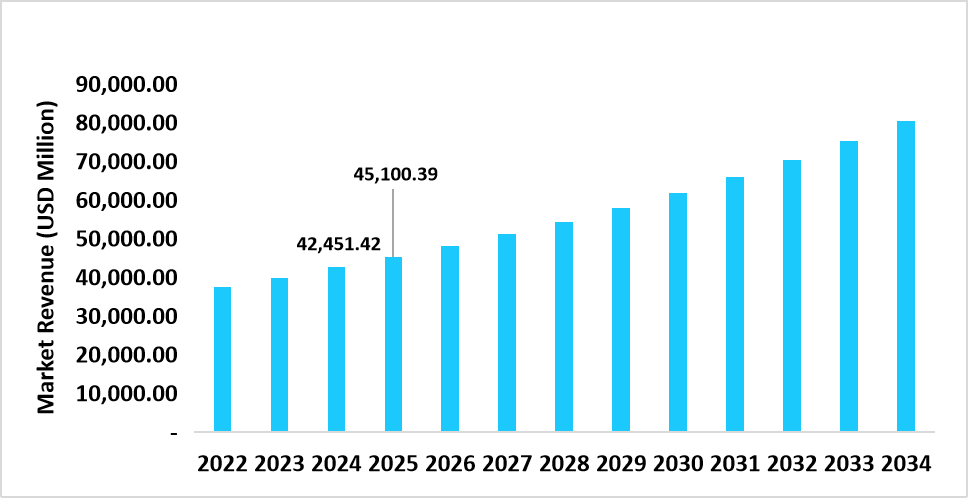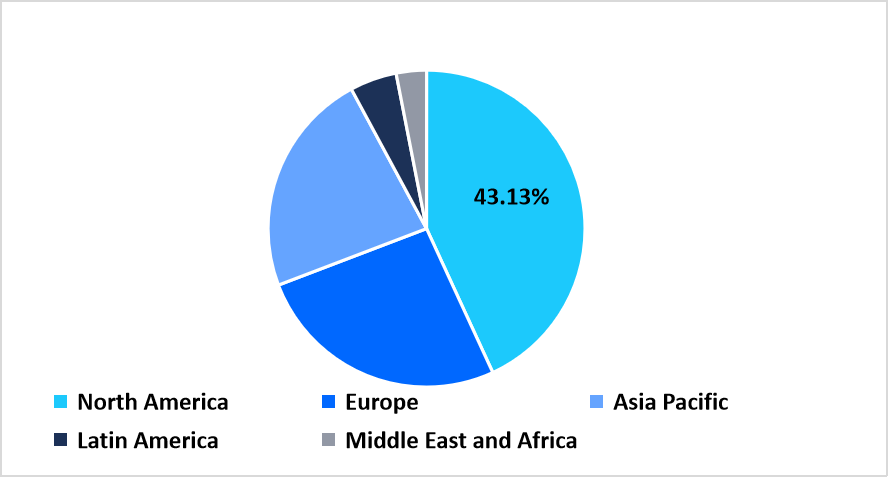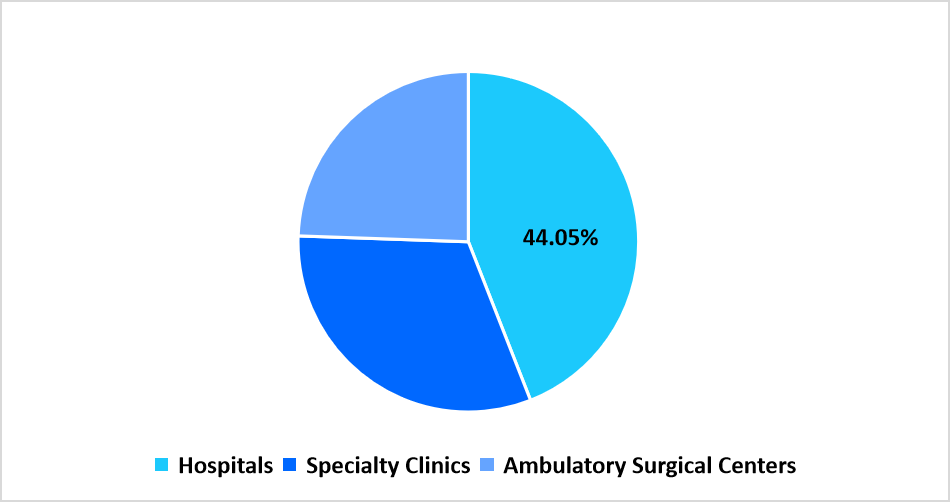Medical Implants Market Overview
The global medical implants market size is estimated at USD 110.53 billion in 2025, and is projected to reach USD 196.94 billion by 2034 at a CAGR of 6.67% during the forecast period. The remarkable growth of the market is due to the rising elective and cosmetic implant demand. The elective procedures, such as breast augmentation, facial contouring, and dental implants, drive the growth of the market. For example, the ISAPS Global Survey 2024 reported 1.66 million breast augmentations worldwide, and also total aesthetic procedures reached 38 million in 2024, a 40% rise since 2020, which further enhances the demand in the market.
Key Market Trends & Insights
- North America held a dominant share of the global market with a market share of 43.47% in 2025.
- The Asia Pacific region is growing at the fastest pace, with a CAGR of 7.18% during the forecast timeframe.
- Based on product, the orthopedic implants segment led, holding a market share of 35.79% in 2025.
- Based on material type, the metals and alloys segment is estimated to grow at a CAGR of 6.91%.
- Based on end user, the hospitals segment led, holding a market share of 44.05% in 2025.
- The U.S. dominates the medical implants market, valued at USD 42.45 billion in 2024 and reaching USD 45.10 billion in 2025.
Table: U.S. Medical Implants Market Size (USD Million)

Source: Straits Research
Market Size & Forecast
- 2025 Market Size: USD 110.53 billion
- 2034 Projected Market Size: USD 196.94 billion
- CAGR (2026-2034): 6.67%
- Dominating Region: North America
- Fastest-Growing Region: Asia Pacific
The global medical implants market comprises a diverse range of devices designed to replace, support, or enhance biological functions, thereby improving patient outcomes across orthopedic, cardiovascular, dental, and other medical fields. By product, the market includes orthopedic, cardiovascular, dental, ophthalmic, facial, breast, and other implants, with orthopedic implants holding the largest share due to the rising prevalence of musculoskeletal disorders, an aging population, and advancements in joint reconstruction and spinal technologies. Cardiovascular implants such as pacemakers, heart valves, and stents are expanding rapidly with increasing cases of heart diseases and adoption of bioresorbable and transcatheter systems, while dental implants are gaining traction owing to aesthetic restoration demand and improved implant materials. Based on material type, metals and alloys dominate due to their strength and biocompatibility, followed by ceramics and biologics driven by superior wear resistance and biointegration, and polymers gaining adoption for lightweight and flexible characteristics. By end user, hospitals lead the market owing to high surgical volumes and advanced infrastructure, while specialty clinics and ambulatory surgical centers are witnessing steady growth with the rise in specialized and minimally invasive procedures. Overall, continuous innovation in biomaterials, 3D printing, and smart implant technologies, coupled with the increasing burden of chronic diseases and an aging global population, is driving the potent expansion of the global medical implants market.
Latest Market Trends
Shift toward Patient Specific, 3D Printed Implants
The medical implants market is rapidly shifting toward patient-specific, 3D printed solutions, offering superior personalization, reduced surgical risks, and faster recovery compared to conventional implants. By using advanced imaging and additive manufacturing, implants can be tailored to match a patient’s exact anatomy, ensuring better functionality and long-term outcomes. At Vinmec Times City International Hospital in Vietnam, surgeons performed a groundbreaking procedure in May 2025. This involved implanting the world’s first fully 3D printed titanium femur in an 8-year-old child with osteosarcoma, designed to accommodate future growth, marking a pioneering advance in pediatric precision orthopedic oncology.
Growth of Smart/Connected Implants with Sensors
The adoption of smart and connected implants with sensors is emerging as a key trend in the medical implants market, enabling continuous monitoring, data transmission, and improved patient outcomes. These implants integrate advanced electronics to track healing, detect infections, and provide real-time feedback to clinicians. Recently, Cochlear introduced the Nucleus Nexa System, the first cochlear implant featuring embedded onboard memory and firmware that has been updated post-implantation, much like a smartphone receiving an OS upgrade. This breakthrough illustrated how connected implants enhanced longevity, reduced revision procedures, and supported personalized, technology-driven healthcare, setting new standards in patient-centric treatment.

To get more insights about this report Download Free Sample Report
Medical Implants Market Drivers
Expanding Insurance Coverage and Favorable Reimbursement
Expanding insurance coverage and favourable reimbursement policies are boosting the global market by improving affordability and access to advanced treatments. These financial mechanisms reduce out-of-pocket costs, encouraging more patients to opt for implants such as orthopedic, dental, and cardiovascular devices. For instance, India's Ayushman Bharat Pradhan Mantri Jan Arogya Yojana covered up to USD 5,700 per family annually for implant procedures. Similarly, Brazil’s Unified Health System funded over 90% of orthopedic procedures, including joint replacements and spinal implants, which supports the market growth as these initiatives drive patient adoption and market growth.
Market Restraint
Risk of Infections, Implant Loosening, Wear, and Revision Surgeries
The global medical implants market faces challenges due to associated complications such as infections, implant loosening, wear, and the demand for revision surgeries, which can impact patient outcomes and healthcare costs. A recent study published in BMC Musculoskeletal Disorders 2024 analyzed 140 patients undergoing revision total knee arthroplasty due to periprosthetic joint infection (PJI) and aseptic loosening. The findings revealed that 45.45% of patients with PJI had infections caused by Staphylococcus aureus, including methicillin-resistant strains. Notably, 54.41% of patients with aseptic loosening had microbial infections detected through droplet digital PCR, despite negative microbial cultures, highlighting hidden risks. These findings underscored the persistent risks associated with implant procedures, limiting adoption in high-risk patient populations.
Market Opportunity
Emerging Potential of Tissue Engineered and Bioresorbable Implants
Advancements in tissue engineering and bioresorbable implants are creating major opportunities in the medical implants market by addressing long-term safety concerns and reducing the demand for revision surgeries. These next-generation implants promote natural tissue regeneration, offering better biocompatibility and improved patient outcomes. Regenity Biosciences secured approval from China’s NMPA for Matrixflex, a bioresorbable collagen dental membrane. The product demonstrated strong clinical results in a head-to-head randomized trial against Geistlich’s Bio-Gide, a leading competitor, and marked Regenity’s first dental implant launch in China, expanding its regenerative medicine portfolio. Such innovations highlighted the growing market potential for bioresorbable and tissue-engineered implants in global healthcare.
Regional Analysis
The North American region dominated the market with a revenue share of 43.13% in 2025. The growth is attributed to the advanced healthcare infrastructure and the rising prevalence of chronic conditions such as cardiovascular diseases, arthritis, and osteoporosis. According to the Bone Health & Osteoporosis Foundation 2024, 1.5 million osteoporosis-related fractures occur annually in the U.S., highlighting strong demand for orthopedic implants.
In the U.S., medical implants are advancing rapidly with technological innovations and growing patient demand. For instance, in May 2025, Paradromics conducted the first human implantation of their Connexus BCI device at the University of Michigan, a dime-sized implant with 420 electrodes translating neural signals into speech and cursor control.
Asia Pacific Market Insights
The Asia Pacific region is projected to grow at the fastest CAGR of 7.18% during the forecast period, driven by a rapidly aging population, higher chronic disease prevalence, and rising healthcare awareness.
The rising focus on indigenously engineered implant technologies is fueling growth in India’s medical implants market, encouraging adoption and reducing import dependency. For instance, in 2024, Meril Life Sciences launched MISSO, a domestically developed robotic-assisted system for orthopedic joint replacements, part of its wider strategy to localize high-precision implant solutions. This trend underscores India’s shift toward self-reliant, cost-competitive innovation in implant care.
By Region Market Share (in percent share %), 2025

Source: Straits Research
Europe Insights
Europe’s medical implants market is advancing through strong regulatory and manufacturing leadership under the EU MDR framework, making it a hub for high-quality implant development. For instance, in 2024, B. Braun expanded its orthopedic implant production in Tuttlingen to meet growing EU demand for joint replacements, leveraging Germany’s reputation for precision engineering and strict compliance standards.
France’s medical implants market is fueled by innovation and support of the government towards R&d. In June 2025, 3D Systems and TISSIUM gained FDA De Novo authorization for COAPTIUM CONNECT, the world’s first fully bioabsorbable 3D printed nerve repair implant.
Middle East and Africa Market Insights
The growing investment in advanced orthopedic and dental care infrastructure through medical tourism initiatives drives the market growth. Countries such as the UAE, Saudi Arabia, and South Africa are positioning themselves as regional hubs for high-quality, affordable implant surgeries, attracting international patients seeking orthopedic joint replacements and cosmetic dental implants.
The increasing prevalence of road traffic injuries and trauma-related orthopedic conditions is fueling the demand for trauma and extremity implants. With one of the highest road accident rates in the region, South Africa faces a burden of fractures and musculoskeletal injuries requiring surgical intervention. This has led to a surge in demand for internal fixation devices, bone plates, and joint reconstruction implants, supported by expanding trauma care centers and the integration of advanced surgical navigation systems in urban hospitals.
Latin America Market Insights
The rising integration of telemedicine and digital monitoring technologies with implantable devices to enhance post-surgical care and patient outcomes enhances the market growth. Countries such as Brazil, Mexico, and Chile are witnessing increased adoption of smart implants embedded with wireless sensors and connectivity features that allow remote tracking of implant performance and early detection of complications.
The increasing collaboration between local biomedical manufacturers and research universities to develop cost-efficient implant solutions tailored to regional healthcare demands further enhances the market growth. Argentina’s strong academic network, including institutions such as the National University of La Plata and Buenos Aires Institute of Technology (ITBA), is actively partnering with domestic medtech firms to design and produce biocompatible orthopedic and dental implants using locally sourced materials. For example, BioImplant Argentina has pioneered the use of titanium 3D-printed cranial and mandibular implants, hence reducing production costs and surgery wait times.
Product Insights
The orthopedic implants segment dominated the market with a revenue share of 35.79% in 2025. This segment’s prominence is driven by the increasing joint replacement surgeries, and advancements in trauma, spinal, and extremities implants, driving demand for orthopedic implants across global healthcare settings.
The cardiovascular implants segment is anticipated to register the fastest CAGR of 7.67% during the forecast period, owing to the increasing demand for minimally invasive and transcatheter procedures, and rapid technological advancements such as bioresorbable stents, next-generation pacemakers, and tissue-engineered heart valves.
Material Type Insights
The metals and alloys segment is expected to grow at a CAGR of 6.91%. These materials are preferred for medical implants owing to their high strength, biocompatibility, corrosion resistance, and long-term durability, making them ideal for orthopedic, cardiovascular, and dental applications.
The biologics segment dominated the market in 2025 with a 23.52% share, driven by the rising adoption of bioresorbable, tissue-engineered, and regenerative materials that promote natural healing and integration with the body’s tissues
End-user Insights
The hospital segment dominated the market, with a revenue share of 44.05% in 2025, supported by advanced infrastructure, specialized surgeons, and high procedure volumes. For instance, U.S. hospitals perform over 1 million joint replacements annually, as reported by the American Academy of Orthopaedic Surgeons, 2024, reinforcing their leadership in implant adoption.
The ambulatory surgical centers (ASCs) segment is anticipated to register the fastest CAGR of 7.02%, due to its ability to offer cost-efficient surgical environments, faster recovery times, and advanced implant technologies that support outpatient orthopedic, dental, and cardiovascular interventions.
By End User Market Share (in percent share %), 2025

Source: Straits Research
Competitive Landscape
The global medical implants market is moderately fragmented in nature due to global leaders’ dominance alongside numerous regional and niche players across diverse implant categories.
Phantom Neuro: An emerging market player
Phantom Neuro is an emerging U.S.-based neurotechnology startup developing advanced muscle implant systems that enable intuitive prosthetic control through neural signals.
- In March 2025, Phantom Neuro’s flagship platform, Phantom X, a next-generation muscle implant system enabled amputees to control prosthetic limbs through thought, received both FDA Breakthrough Device Designation and Targeted Acceleration Pathway (TAP) Designation, expediting regulatory approval and highlighting its potential in advanced neurotechnology.
List of key players in Medical Implants Market
- Medical Device Business Services, Inc.
- Medtronic
- Zimmer Biomet
- Stryker
- Smith & Nephew
- Boston Scientific Corporation
- Abbott
- Institut Straumann AG
- Dentsply Sirona
- Biotronik
- Braun SE
- Edwards Lifesciences Corporation
- NuVasive, Inc.
- Globus Medical
- LivaNova PLC
- Phantom Neuro
- Osseointegration Group
- Cochlear Ltd.
- Integra LifeSciences Corporation
- Nevro Corp
- Others

To get more findings about this report Download Market Share
Strategic Initiatives
- August 2025- Curieva, Inc. unveiled its Anterior Lumbar Inspire Portfolio, an advanced spinal implant system that included both monolithic and standalone implant designs, along with a comprehensive plating system for construct support. This launch marked a major progression in lumbar vertebral stabilization options.
- July 2025- Evonik inaugurated its largest medical device center in Shanghai, dedicated to R&D and processing of bioresorbable polymers used in implants such as orthopedic screws, pins, and cardiovascular scaffolds.
- April 2025- 3D Systems, in collaboration with University Hospital Basel (Switzerland), achieved a milestone: the world’s first MDR-compliant, 3D printed PEEK facial implant manufactured at the point of care. This implant was produced using their EXT 220 MED printer directly in the hospital and used successfully in a surgery on March 18, 2025.
Report Scope
| Report Metric | Details |
|---|---|
| Market Size in 2025 | USD 110.53 Billion |
| Market Size in 2026 | USD 117.51 Billion |
| Market Size in 2034 | USD 196.94 Billion |
| CAGR | 6.67% (2026-2034) |
| Base Year for Estimation | 2025 |
| Historical Data | 2022-2024 |
| Forecast Period | 2026-2034 |
| Report Coverage | Revenue Forecast, Competitive Landscape, Growth Factors, Environment & Regulatory Landscape and Trends |
| Segments Covered | By Product, By Material Type, By End User, By Region. |
| Geographies Covered | North America, Europe, APAC, Middle East and Africa, LATAM, |
| Countries Covered | U.S., Canada, U.K., Germany, France, Spain, Italy, Russia, Nordic, Benelux, China, Korea, Japan, India, Australia, Taiwan, South East Asia, UAE, Turkey, Saudi Arabia, South Africa, Egypt, Nigeria, Brazil, Mexico, Argentina, Chile, Colombia, |
Explore more data points, trends and opportunities Download Free Sample Report
Medical Implants Market Segmentations
By Product (2022-2034)
- Orthopedic Implants
- Joint Reconstruction Implants
- Trauma & Extremities Implants
- Spinal Implants
- Cardiovascular Implants
- Pacemakers
- Heart Valves
- Stents & Grafts
- Dental Implants
- Ophthalmic Implants
- Facial Implants
- Breast Implants
- Others
By Material Type (2022-2034)
- Metals & Alloys
- Ceramics
- Biologics
- Polymer
By End User (2022-2034)
- Hospitals
- Specialty Clinics
- Ambulatory Surgical Centers
By Region (2022-2034)
- North America
- Europe
- APAC
- Middle East and Africa
- LATAM
Frequently Asked Questions (FAQs)
Debashree Bora
Healthcare Lead
Debashree Bora is a Healthcare Lead with over 7 years of industry experience, specializing in Healthcare IT. She provides comprehensive market insights on digital health, electronic medical records, telehealth, and healthcare analytics. Debashree’s research supports organizations in adopting technology-driven healthcare solutions, improving patient care, and achieving operational efficiency in a rapidly transforming healthcare ecosystem.
Speak To AnalystAvailable for purchase with detailed segment data, forecasts, and regional insights.
Get This ReportOur Clients:










































